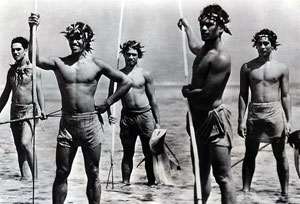
Tabu: A Story Of The South Seas

TABU: A STORY OF THE SOUTH SEAS (MOVIE)
Paramount Pictures
Original release: August 1st, 1931
Running time: 84 minutes
Director: F.W. Murnau
Writers: F.W. Murnau, Robert J. Flaherty
Cast: Matahi, Anne Chevalier, Hitu

Those flickering images on the silver screen have an uncanny ability to transcend the period and geography of their inception, becoming timeless and universal. An exceptional film can feel as fresh and exciting now as the day it was first screened to an enraptured audience. One of the joys of great art is often its agelessness. Having said that, the fingerprints left by the situation of the piece’s creation, the moment and place in which it was born, can hold an equal fascination. In some instances those aspects combine to create an absorbing peek into an alien bygone era and a compelling and relevant experience.
This is most certainly the case with the last film from German director Friedrich Wilhelm Murnau, Tabu: A Story Of The South Seas. My first encounter with it – aside from a general awareness of its existence – actually came through a far more recent release with the same name. Tabu (2012), Mario Gomes’ mesmerising experiment in melancholy, was named for Murnau’s earlier piece and alludes to it in a variety of ways.
A fable about attempting to outswim the sinister forces of destiny, Murnau’s Tabu presents a look at life on the Polynesian island of Bora Bora. This isn’t the tourist trap we might expect today, though, the film shows off the exotic and unsullied nature of the island as it was in the 1920’s and tells a tale set amongst its ‘primitive’ peoples. Using locals as actors and shot entirely on location, this may seem an odd choice for a commanding auteur such as Murnau, but there’s a thickening plot behind the lens as much as in front of it.
Feeling disillusioned with Hollywood, Murnau was effectively in last chance saloon with Fox Films having had only muted success since the extraordinary Sunrise: A Song Of Two Humans (1927). Desperate to get away from the Dream Factory, he struck up a volatile collaboration with Nanook Of The North (1922) documentarian Robert J. Flaherty who was similarly struggling to get ahead at Fox and whose latest feature had been shut down. Together, they sailed off to the South Seas in search of a film in the innocent idyll of Tahitian islands. Although their relationship deteriorated, and the final film is largely Murnau’s, the story was crafted together and shows signs of both men’s perspectives.

It all comes together into a film that was very much of its time – exploring this new culture with joy but an unavoidable condescension. The action kicks off with a group of young natives fishing in the lagoon with spears and splashing beneath the cascades of a nearby waterfall – Flaherty through and through. It soon becomes clear two of these youths, a boy named Matahi and the beautiful Reri (Anne Chevalier), are very much in love. Disaster soon arrives in the shape of a westerners’ schooner, however.
The wonderfully menacing Hitu, a priest from a nearby island, alights to inform the islanders that a sacred virgin has died and that Reri has been selected to take her place. As such, she’s designated ‘tabu’ which essentially means that she’s placed under prohibition on sacred grounds. Naturally, Matahi’s heartbroken, but resolves not to give up on his love and steals her away from under Hitu’s nose. They flee to another island full of western traders, where Matahi’s prowess at diving for pearls earns him a reputation and he becomes immediately popular. It’s not long before the shadow of Hitu has followed them across the water.
It’s very easy to see the coming together of two disparate world views in the story of Tabu. On one hand, the idealistic Flaherty’s fingerprints can be seen on elements like  the innocent joy of life on Bora Bora and particularly in the way that Matahi’s duped by traders on the second island who effectively trick the unfortunate naïf into their debt. Then there’s the fatalistic Murnau ultimately steering the ship and charting an ultimately doomed course for the lovers.
the innocent joy of life on Bora Bora and particularly in the way that Matahi’s duped by traders on the second island who effectively trick the unfortunate naïf into their debt. Then there’s the fatalistic Murnau ultimately steering the ship and charting an ultimately doomed course for the lovers.
The director eschews inter-titles providing a purely silent film and never allowing us to miss a beat. As the end of their romance approaches, it becomes almost overwhelming. Matahi makes a decision to dive for pearls at a rich point in the lagoon that’s also, ominously, been marked as ‘tabu’ due to harbouring a fierce shark. The wrath of the Tahitian gods seems inevitable for this young man desperate to reach for the things he is forbidden from.
I’m always a sucker for seemingly doomed love stories anyway – many of my favourite films revolve around them – but Tabu provides a thrilling finale that gets the heart pounding and avoids sentimentality. The clash of ideals behind the camera, and the collision of cultures on the screen, combine to glorious effect for a film that Murnau himself tragically never saw released.


Ben Nicholson
Ben has had a keen love of moving images since his childhood but after leaving school he fell truly in love with films. His passion manifests itself in his consumption of movies (watching films from all around the globe and from any period of the medium’s history with equal gusto), the enjoyment he derives from reading, talking and writing about cinema and being behind the camera himself having completed his first co-directed short film in mid-2011.
His favourite films include things as diverse as The Third Man, In The Mood For Love, Badlands, 3 Iron, Casablanca, Ran and Grizzly Man to name but a few.
Ben has his own film site, ACHILLES AND THE TORTOISE, and you can follow him on Twitter @BRNicholson.
© 2022 STATIC MASS EMPORIUM . All Rights Reserved. Powered by METATEMPUS | creative.timeless.personal. | DISCLAIMER, TERMS & CONDITIONS
HOME | ABOUT | CONTACT | TWITTER | GOOGLE+ | FACEBOOK | TUMBLR | YOUTUBE | RSS FEED
CINEMA REVIEWS | BLU-RAY & DVD | THE EMPORIUM | DOCUMENTARIES | WORLD CINEMA | CULT MOVIES | INDIAN CINEMA | EARLY CINEMA
MOVIE CLASSICS | DECONSTRUCTING CINEMA | SOUNDTRACKS | INTERVIEWS | THE DIRECTOR’S CHAIR | JAPANESE CINEMA





